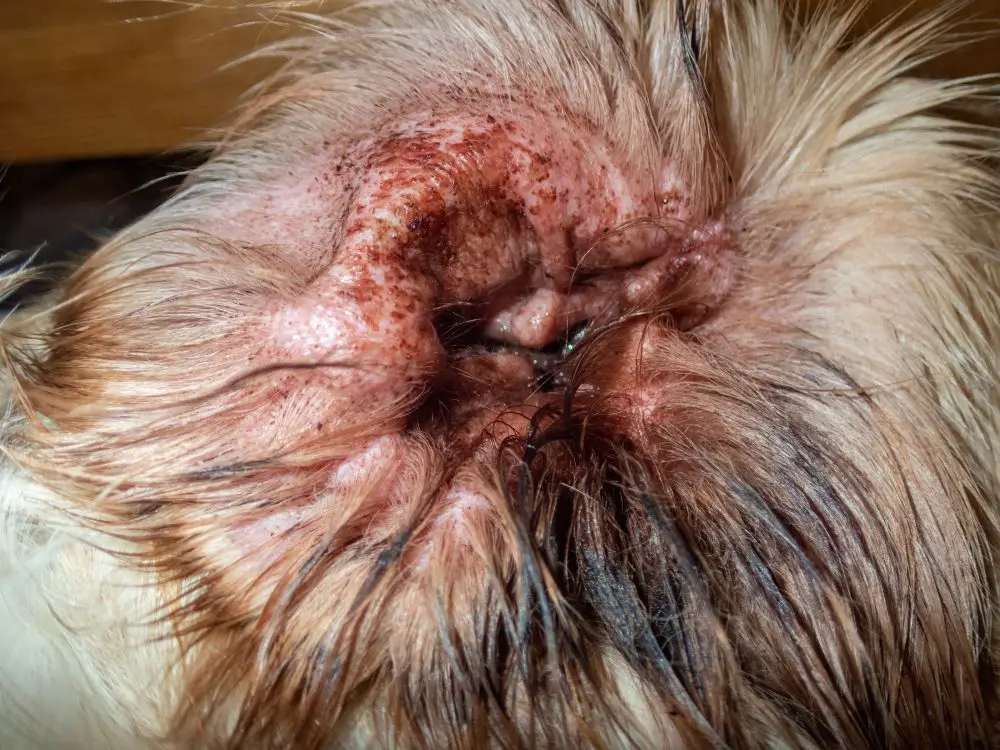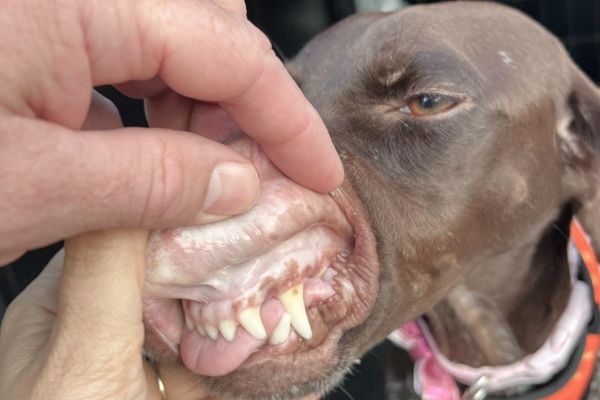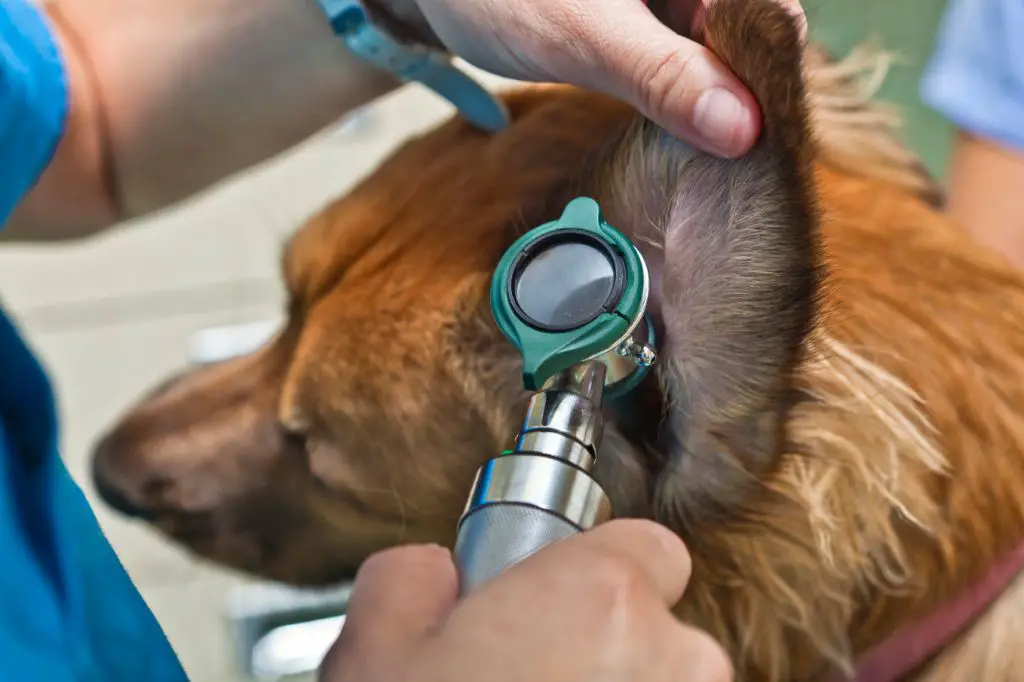Normal Inner Ear Color
The interior lining of a dog’s ear is typically light or bubblegum pink in color, similar to the color of a person’s lips. This pink coloration is considered normal and healthy for most dog breeds. The pink color comes from the blood flow and tissues present inside the pinna, or flap of the ear. While the exact shade can vary from pale to bright pink, the general color should be uniform without any spots, marks, or color variation when looking inside a dog’s healthy ear.
Some factors like breed, age, and skin pigmentation can cause the inner ear to appear slightly darker or lighter pink than average. However, a healthy pink ear canal free of discharge, odor, or irritation is ideal. Being familiar with the normal pink color inside your dog’s ears makes it easier to spot any abnormalities or changes over time. Overall, a light pink inner ear is a sign of wellness in dogs.
Why Inner Ears are Pink
The inside of a dog’s ears are pink due to the blood vessels, thin skin, and lack of melanin in that area. More specifically, a dog’s ears contain many blood vessels close to the surface which gives them the pinkish hue. The blood vessels warm the ears and help regulate body temperature. Additionally, the skin lining a dog’s ear canal is very thin with little to no hair, so the skin’s natural pigment does not block the blood vessels from being seen. Dog ears also lack a dark pigment called melanin which contributes to their pink color. The skin contains very little melanin, unlike a dog’s fur which does contain melanin and gives it color. So in summary, the combination of extensive blood vessels near the skin’s surface, thin hairless skin, and lack of melanin pigment all contribute to the light pink color inside healthy dog ears.
Changes in Color
A dog’s inner ear color can change from the normal pink for a variety of reasons. Some common causes of color changes include:
Infections – Bacterial or yeast infections in the ear canal can cause redness and inflammation, leading to a redder ear color.

Allergies – Allergies to foods, medications, environmental triggers like pollen can also cause red, inflamed ears.
Sun exposure – Over exposure to UV rays can cause skin damage and hyperpigmentation or dark spots on the delicate ear skin over time.
Pigmentation – Some dogs naturally develop more pigment in their ear skin as they age, leading to black or darker colored inner ears.
It’s important to keep an eye on any color changes in your dog’s ears and have them checked by your veterinarian, as discoloration often signals an underlying issue like an infection or allergy that needs treatment.
Red Inner Ears
Seeing redness inside your dog’s ears is usually a sign of an underlying issue that requires veterinary attention. Potential causes of red inner ears in dogs include:
- Ear Infections – Bacterial and yeast infections are common causes of inflammation and redness inside a dog’s ears. Infections cause irritation, itchiness, and discomfort. As the infection worsens, the inner ear becomes increasingly red, swollen, and painful.
- Allergies – Dogs with food or environmental allergies may develop red, irritated ears due to scratching, head shaking, and inflammation. Allergic reactions can cause changes in ear canal pH, allowing yeast and bacteria to overgrow.
- Foreign Objects – Grass seeds, foxtails, or other foreign material trapped inside the ear canal can cause redness and irritation as they rub against the delicate skin.
- Autoimmune Diseases – Autoimmune conditions like hypothyroidism or immune-mediated ear diseases can manifest with red, inflamed ears.
- Sunburn – Dogs with thinly haired or unpigmented ear flaps are prone to sunburn if exposed to excessive UV radiation. The sensitive skin inside the ears can burn and become red.
- Trauma – Any injury to the inside of the ear, like a scratch or bite wound, will result in redness as it heals.
If your dog’s ears appear red for more than a day or two, it’s best to visit your veterinarian for an examination. Leaving ear infections or other underlying problems untreated can lead to complications like hearing loss. Prompt diagnosis and treatment will provide relief and prevent more serious issues in the future.
Black Inner Ears

Some dogs naturally have black inner ears due to the pigment melanin. Melanin is what gives skin, hair, and eyes their color. Dogs with black skin and hair follicles will also have black inner ears.
Examples of dog breeds that often have black skin and ears include:
- Poodles
- Schipperkes
- Chinese Shar-Pei
- Chow Chows
- German Shepherds
- Rottweilers
For these breeds, black inner ears are completely normal. The black color comes from melanin in the skin and is not a cause for concern.
However, if a dog’s ears suddenly turn black or appear darker than normal, it could potentially indicate a medical issue such as a blood clot or trauma. As with any abnormal change, it’s a good idea to point it out to your veterinarian.
White/Pale Inner Ears
If your dog’s inner ears start to lose their pink hue and turn white or pale, it can be a sign of an underlying health issue. There are a few potential causes for this change in pigmentation:
Anemia – Anemia is a reduction in red blood cells or hemoglobin that can make a dog’s inner ears appear pale or white. Since red blood cells carry oxygen, anemia leads to decreased oxygen delivery throughout the body. There are several different causes of anemia including blood loss, destruction of red blood cells, or lack of production. If your dog’s inner ears turn pale, it’s important to get them checked for anemia.

Parasites – Certain parasites like hookworms feed on a dog’s blood and can cause anemia. The blood loss leads to pale inner ears along with symptoms like lethargy, weakness, and weight loss. Deworming medication will be needed to kill off the parasites and resolve the anemia.
Allergies – Allergic reactions can sometimes cause inflammation and fluid buildup in a dog’s inner ears. This swelling presses on blood vessels and restricts blood flow, leading to pale ear pigmentation. Identifying and removing the allergen is key, along with medication to reduce inflammation.
In addition to the color change, dogs with pale inner ears may show symptoms like fatigue, intolerance to exercise, rapid breathing or pale gums. It’s important to have your vet examine your dog if their inner ears lose color, since pale ears are often a clinical sign of anemia or health problem that requires treatment.
Spotted/Speckled Inner Ears
Some dog breeds naturally have spotted or speckled ears as part of their markings. This includes breeds like Dalmatians, Australian Cattle Dogs, and English Setters. The spots or speckles are simply a part of their coat coloration and are completely normal.
However, spots or speckles can also indicate some medical conditions:
- Sun damage – Dogs with light-colored ears like white or pink are prone to sunburn and damage. Prolonged sun exposure can cause dark freckling and spotting on the delicate ear skin.
- Allergies – Allergic reactions can cause itchy ears in dogs, leading them to scratch excessively. This irritation creates dark speckles or scabs on the inner ears.
So while breed-specific spotting is normal, random new spots may signal sunburn or allergies. Check for additional symptoms like redness, swelling or scratching at the ears. Seek veterinary advice if the speckling seems abnormal or worrisome.
When to See a Vet
In most cases, minor color changes in your dog’s inner ears are harmless and no cause for concern. However, there are certain situations where you will want to schedule an appointment with your veterinarian to have your dog’s ears examined:
- If the inside of the ears appear bright red and inflamed, this could signal an infection or inflammation that requires treatment.
- If there is a dramatic color change, like the ears turning from pink to black, it could indicate a more serious underlying issue.
- If there are any wounds, sores, bumps or growths inside the ear, these should be checked by a vet.
- If your dog is frequently scratching or rubbing the ears, seems to be in pain, or you notice any discharge or odor, a vet visit is warranted.
- If the color change is accompanied by head shaking, loss of balance, or other concerning symptoms, seek veterinary care promptly.

While many minor color variations are nothing to fret over, it’s always a good idea to have your vet take a look if anything seems abnormal or persists longer than a few days. Pets can’t tell us when something is wrong, so it’s up to us as owners to watch for any signs of trouble. When in doubt, call your vet to discuss your dog’s ears and determine if an exam is needed.
Caring for Dog Ears
Keeping your dog’s ears clean and healthy is an important part of overall care. Here are some tips for proper ear care:
-
Check ears weekly for signs of infection like odor, discharge, swelling, or redness. Clean gently with a cotton ball and veterinarian-recommended cleanser to keep ears free of dirt and debris.
-
After baths or swimming, gently dry inside ears with a cotton ball to prevent moisture buildup.
-
Do not insert anything into the ear canal such as cotton swabs as this can damage the delicate skin. Only clean outer ear.
-
Trim hair around the ears that can trap moisture and debris. Be very careful not to nick the skin.
-
If ears smell bad or your dog is scratching or shaking their head frequently, see your veterinarian to check for infection.
-
Follow any ear cleaning instructions from your veterinarian, especially if your dog has chronic infections or allergies.
-
Avoid exposing ears to irritants like cigarette smoke, which can increase the risk of ear infections.
Keeping dog ears clean and monitoring for any signs of problems is important for their health and comfort. Consult your veterinarian if you have any questions or concerns about caring for your dog’s ears.
Summary
A dog’s inner ears are often pink in color, which is normal and healthy. This pink color comes from the blood vessels and thin tissue of the ear flap. While pink is typical, some variations in color can occur. For example, black inner ears may just be a trait of the breed or caused by melanin pigment. Redness could simply mean inflammation from infection or trauma. However, dramatic color changes like pale white ears or spotting and speckling can potentially indicate an immune disorder or skin condition that requires veterinary attention. It’s important to monitor your dog’s ear color and check for any bad odors, debris, swelling or discomfort. Healthy ears should appear clean and pink, without excessive redness, discharge or foul odor. See your vet promptly about abnormal ear color changes to rule out any underlying medical causes. With proper care and treatment if needed, your dog’s ears can return to their normal vibrant pink.